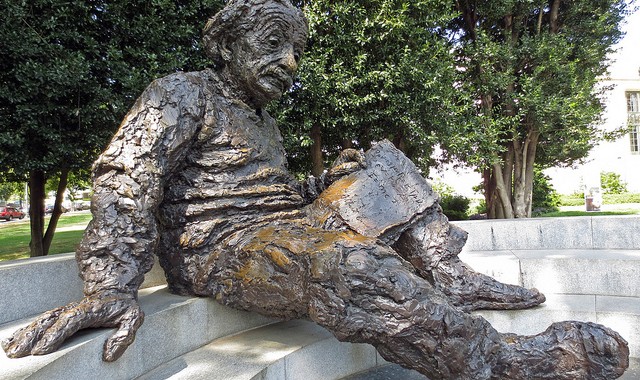On February 22, the National Academy of Sciences hosted a workshop titled “Developing Indicators for Undergraduate STEM Education.” The Board on Science Education welcomed the public to join them as they explored “existing indicators and measures of the quality of undergraduate education generally and undergraduate STEM education specifically.” The workshop was designed to inform a study committee charged to identify objectives for undergraduate STEM and develop national indicators of quality in two-year and four-year STEM education.
The following notes represent some highlights from the workshop that might be of particular interest to the NCSCE/SENCER community.
USC Center for Urban Education’s Equity Scorecard
Alicia Dowd, Pennsylvania State University
Alicia Dowd, professor of education at the Pennsylvania State University (PSU) College of Education and senior scientist in PSU’s Center for the Study of Higher Education, discussed the University of Southern California’s Center for Urban Education’s Equity Scorecard, which she was instrumental in developing. She opened her presentation by highlighting the difference between equity and equality, and emphasizing the importance of equity as a metric. She recommends that teachers take a careful look at their own practice to notice any equity gaps. Once these gaps are identified, they can be investigated more deeply.
The Community College of Aurora’s math department adopted this practice and closed its equity gap after examining their data instructor by instructor. This took some time and trial and error to achieve. Their initial intervention was successful, but disproportionately advantaged white students. Since, as Alicia emphasized, “a system that produces inequities is not a high quality system,” further adjustments were made and the math department was able to close its equity gap while still seeing learning gains compared to pre-intervention levels.
Alicia also noted that solutions are more powerful when they emerge, not when they’re prescribed, so to make changes that lead to equity, it’s best for teachers to look at their own data and create their own responses because equitable education varies by setting. A helpful place to start is often asking teachers to look at their syllabi and ask, “Does this convey respect for my students?”
There are also plenty of institutional changes that can be made to improve the education system as a whole. For example, taking a look at the advising resources provided to students who have declared and undeclared majors could be a first step in ensuring that no inequities exist between these two groups. Another example is to work toward an intervention for students who fail to graduate because they are unable to fulfill their required math credits. This is a problem especially because many students aren’t able to pass pre-requisites that qualify them to take required courses in the first place. NCSCE’s Engaging Mathematics partners have observed this problem on their campuses and are beginning to work toward solutions, such as creating a new required course option on the history of mathematics at Metropolitan State University. The course’s structure would be fundamentally different, but no less challenging, than a tradition math course, and assessments would be done through projects, papers, and other methods, instead of through testing, to avoid triggering deep-seeded fear of math in students who have struggled with the subject significantly in the past.
Alicia also recommends surveying teachers to find out if they believe in their ability, or their institution’s ability, to close equity gaps. People need to believe change is possible. If they don’t, the reasons why should be determined, and then resources to help should be provided. Other strategies that can help teachers adopt investigative practices include (1) institutional leaders creating opportunities for faculty to interact with school and course level data, and data at the course sequencing level, (2) making sure data are disaggregated by race/ethnicity, because “what gets counted counts”, (3) having promotion and tenure reward these practices, (4) scheduling office hours in tutoring centers rather than in faculty offices, (5) dropping arbitrary requirements to get into a major, (6) stop expecting faculty to be exceptional teachers and evaluating them based on their research, and (7) changing hiring practices to make them more equitable.
Federal Data and Indicator Systems
Overview of the NSF Science and Engineering Indicators
Beethika Khan, National Center for Science and Engineering Statistics
The STEM Education Resource and Revisiting the STEM Workforce
Matthew Wilson, National Science Board
Beethika and Matthew both discussed the National Science Board Science and Engineering Indicators 2016, which provide data on “the U.S. and international science and engineering enterprise.” The biggest takeaway from this year’s Indicators is that attrition from STEM fields is not different from other fields, as was previously assumed.
The 2016 Indicators are more user-friendly and comprehensible than they’ve been in the past. They contain policy-neutral sections, such as the Digest and State Data Tool. Companion reports that go into what the data means for policy are also available, such as Revisiting the STEM Workforce. Additional companion briefs that address policy will be released later this year.
Another insight from the Indicators is that there is no single, monolithic “STEM workforce,” so it is hard to say whether there is a glut or shortage of STEM workers without more clearly defining what that workforce actually is. It’s better, Beethika and Matthew suggest, to look at the skills and expertise all students need to optimize their career options, instead of what degrees they pursue. Since the line between STEM and non-STEM workers is blurring, working toward a more STEM-capable workforce, and exploring why students are pursuing certain pathways, rather than just looking at numbers like attrition, would be more valuable goals.
In the future, the Indicators could benefit from longitudinal data and accessible, flexible district-level data. The national data available for community colleges are also very limited.
For more information about the workshop, visit this webpage where you can view the agenda and speaker biosketches. A recording of the event and presenter slideshows will also be posted to the page once they become available.
Photo credit: Joe Loong (CC BY-SA 2.0)

